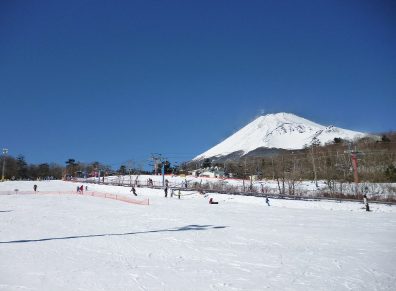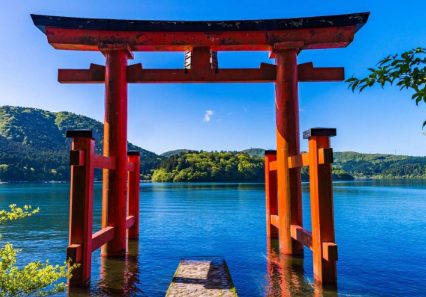Mount Fuji guide
At 3776 meters high, Mount Fuji stands as the highest peak in Japan and a symbol of national significance. Its near-perfect, isolated volcanic shape has been a subject in numerous forms of art for centuries. Art collections often strive to encapsulate its beauty from different perspectives, with Hokusai’s renowned series “36 Views of Mount Fuji” being a notable example.
Travelers have numerous chances to appreciate the beauty of Mount Fuji. Climbing the mountain is an evident choice, where views of its slopes are unavoidable during the ascent to the summit. However, the climbing season is limited to just a few months, and it’s often said that Mount Fuji’s true beauty is best observed from a distance rather than up close.
Mount Fuji’s majestic presence can be observed from numerous vantage points in the neighboring areas, each offering a unique perspective of the mountain. On exceptionally clear days, its snow-capped summit is visible from hundreds of kilometers away. However, it’s common for clouds or haze to obscure the view. For the best chances of a clear sighting, aim for early morning or late afternoon, particularly in the colder winter months when visibility is generally superior to that in the summer. The iconic snow cap of the mountain is usually seen from approximately November to May.
● Reaching from Tokyo
Reaching the awe-inspiring Mount Fuji by train is both easy and convenient. Here are your best options:
- Via JR Chuo Line and Fujikyu Railway: Kick off your trip at Shinjuku Station, hopping onto the JR Chuo Line. Your key stop is Otsuji Station, where you’ll switch to the Fujikyu Railway heading towards Kawaguchiko Station. This pathway is known for its directness and efficiency in getting you to Mount Fuji.
- Through Odakyu Line and Hakone Tozan: For those seeking variety in their travel, the Odakyu Line from Shinjuku is a great start. After this leg, you can continue either by Hakone Tozan bus or train, each leading you towards the majestic Mount Fuji in their unique way.
- The Fuji Excursion Train Option: Introduced in 2019, the Fuji Excursion train is possibly the most straightforward route. It offers a direct journey from Tokyo to Kawaguchiko, eliminating the need for train changes. Additionally, the covers the cost of this trip, making it a budget-friendly alternative.
Each of these routes promises a scenic and memorable journey to Mount Fuji, setting the stage for an experience filled with breathtaking views and unforgettable moments.
● When to plan:
When planning a trip to Mount Fuji, timing is key for those seeking the clearest views of this majestic mountain. Here’s a guide to the optimal times for your visit:
- November to February: Often hailed as the prime window for visiting Mount Fuji, these months typically bring clearer weather, boosting your chances of enjoying an unobstructed view. For the crispest visibility, early mornings are your best bet, so aim to schedule your outings around dawn.
- April and May: In these spring months, the base of Mount Fuji transforms with a vibrant display of pink moss. This stunning natural tapestry is not only a feast for the eyes but also makes the mountain easier to spot from afar. This period coincides with the enchanting Fuji Shibazakura Festival, adding an extra layer of allure to your visit.
- June to August: Be prepared for a bit more challenge during these months, as cloud cover tends to obscure the mountain, making clear views a rarity.
Remember, Mount Fuji’s towering presence can still be elusive behind clouds, so hoping for a cloudless day is part of the adventure. Also, for those in Tokyo, keep an eye out on exceptionally clear days – you might just catch a breathtaking glimpse of Mount Fuji from the city!
What to do and what to see:


- Snow Town Yeti: Snow Town Yeti, nestled on Mount Fuji’s southern slope, stands out as a quaint ski resort. It’s one of just two resorts located on Mount Fuji, sharing this distinction with Fujiten. Known for being among the first in Japan to welcome skiers each season, it typically opens from mid to late October, utilizing artificial snow. The resort features a modest terrain park complete with jumps and rails, alongside a dedicated area for children’s snow activities, sledding, and novice skiers. To ensure a steady supply of snow, especially during periods when natural snowfall is scarce, the resort relies on snow cannons to produce artificial snow, a fairly common practice there.
- Climbing Mount Fuji: Ascending Mount Fuji, Japan’s tallest and most iconic peak at 3776 meters, is an unforgettable adventure. The panoramic views on clear days, coupled with the unique experience of trekking in the early hours alongside a diverse group of hikers from around the globe, make it truly rewarding. The official climbing season spans early July to mid-September, during which the trails and mountain facilities are operational. The allure of climbing Mount Fuji attracts not just locals but also a significant number of international tourists, who constitute over a third of the climbers. The busiest period for scaling the mountain coincides with the school holidays, typically from around July 20 until the end of August, marking it as the peak season.
- Subashiri 5th Station: Of the four 5th stations on Mount Fuji, the Subashiri 5th Station, located on the mountain’s eastern flank, ranks as the second most accessible via public transit from Tokyo, following the Fuji Subaru Line 5th Station. During the climbing season, which typically lasts from mid-July to mid-September, buses operate daily to this station. Additionally, service extends to weekends and national holidays from May to October, providing convenient access for climbers and visitors.
- Fujinomiya 5th Station: The Fujinomiya 5th Station holds the position of being the second most frequented and developed among Mount Fuji’s four 5th stations. For those traveling from western Japan, it offers the most straightforward public transportation access, with direct bus services available from Shin-Fuji and Mishima stations, which are part of the JR Tokaido Shinkansen line.
- Fuji Subaru Line 5th Station: Situated roughly at the midpoint of the Yoshida Trail, which stretches from the base’s Fujiyoshida Sengen Shrine to the summit, the Fuji Subaru Line 5th Station is the most frequented among the four 5th stations on Mount Fuji. Known for its superior development and the ease of access via public transportation from Tokyo, it stands as a prominent starting point for many climbers and visitors.
- Fujiten Snow Resort: Located in the Fuji Five Lakes area, Fujiten Snow Resort is a cozy ski destination at the northern foothills of Mount Fuji. It stands out as the larger of the two ski resorts on the mountain, the other being Snow Town Yeti on the southern side. Fujiten boasts excellent facilities and picturesque views of Mount Fuji. The resort caters to skiers of all skill levels, featuring a range of runs. It includes two main 1300 meter courses ideal for beginners and a 500 meter family slope specifically designed for novice skiers. For those seeking more challenging terrain, Fujiten also offers advanced slopes and a terrain park equipped with large jumps, rails, and boxes, drawing skilled skiers and snowboarders alike.
- Gotemba 5th station: The Gotemba 5th Station, located on Mount Fuji, is the most undeveloped among the four 5th stations. It features a modest setup, including a tiny store, a bus stop, restrooms, and a parking area. Sitting at an altitude of just 1400 meters above sea level, it’s notably the lowest of the 5th stations. This results in the Gotemba Trail being the lengthiest route leading to the mountain’s summit.
● Places to see around Mount Fuji


- Fuji five lakes: Located at the northern foot of Mount Fuji, the Fuji Five Lake area is situated approximately 1000 meters above sea level, encompassing the lakes Kawaguchiko, Saiko, Yamanakako, Shojiko, and Motosuko. This region is renowned as one of the prime spots for close-up views of Mount Fuji and serves as an excellent starting point for those intending to climb the mountain. Of these lakes, Lake Kawaguchiko is the most accessible and provides the widest array of attractions and activities, particularly for international visitors.
- Hakone: Hakone, a section of the Fuji-Hakone-Izu National Park, is located under 100 kilometers away from Tokyo. It is well-known for its hot springs, scenic beauty, and the picturesque view of Mount Fuji across Lake Ashinoko. This makes Hakone a favored getaway for both Japanese and international visitors seeking respite from the hustle and bustle of Tokyo.
- Fujiomiya: Situated in Shizuoka Prefecture, Fujinomiya is a city on the southwestern side of Mount Fuji. The city developed around the Fujinomiya Sengen Shrine, a significant and central shrine in the area, traditionally known as the starting point for ascents up the mountain. Today, many climbers begin their journey to the summit from the Fujinomiya 5th Station, as it offers one of the shortest and most favored routes to the top.
● Where to stay
Budget friendly:
- Ururun Kawaguchiko:
- Kawaguchiko Cottage Minami
- Guesthouse Honobono
- Umeya Annex
Mid rise:
- Jinya Fujikawaguchiko
- Hostel Michikusa-ya
- Private Hotel Rei
- Fuji Fabric Stay
Luxurious:
- Fufu Kawaguchiko
Fujikawaguchiko Onsen Konanso
● How long should I spend in Mount Fuji?
Tailoring your trip to the Mount Fuji region can depend greatly on your personal interests and the type of experience you’re seeking. Here’s a guide to help you decide how long to stay:
- Single day trip: If your schedule is tight, consider a day-long excursion from Tokyo to Mount Fuji. This short visit is sufficient to capture a splendid first impression of the iconic mountain and its scenic surroundings.
- Two to three days: For those looking to immerse themselves deeply, spending 2 to 3 days in the Mount Fuji area is ideal. This lengthier stay allows you to fully engage in a range of activities, from adventurous hiking and mountain climbing, to unwinding in a relaxing hot spring, visiting historical shrines, and seizing the opportunity to witness the stunning vistas of the national park.
The length of your visit should ultimately reflect your personal preferences and desired experiences. Mount Fuji caters to everyone, from those seeking a brief escape to those desiring a more prolonged and in-depth adventure. With an array of fascinating sights and activities, Mount Fuji welcomes all types of travelers for an unforgettable experience.
● What to experience
The list below includes these and other excellent locations for enjoying views of Mount Fuji:
From Tokyo:
During clear weather, numerous observation decks in Tokyo provide captivating views of Mount Fuji, set against Tokyo’s urban skyline. Improved air quality has led to an increase in the days Mount Fuji can be seen from central Tokyo, with the current count exceeding 120 days annually.
- Bunkyo civic center: Among Tokyo’s many observation decks, the Bunkyo Civic Center, situated in a central area, offers particularly stunning views of Mount Fuji, prominently visible behind the high-rise buildings of the Shinjuku district.
Hours: 9:00 to 20:30 Closed: 3rd Sunday in May, December 29 to January 3 Admission: Free
- Mount Takaosan: Mount Takaoson is a wooded mountain situated in the western Tokyo. It is so nearby to the people of Tokyo that here they can stroll around the nature and do an adventurous hike as well. On clear days, Mount Fujin can be seen from the top of the mountain’s summit or through a trail passing westwards.
From Shinkansen:
The Tokaido Shinkansen line travels to the south of Mount Fuji, providing passengers with glimpses of the mountain from their fast-moving trains. Additionally, there are vantage points located south of the railway tracks that offer opportunities to witness the Shinkansen trains passing by with Mount Fuji in the background.
- From the train: Mount Fuji can be seen in between the journey of Tokyo and Osaka from a Tokaido Shinkansen. The best can be seen from Shin-Fuji station, which is 40-50 minutes into the journey from Tokyo and the mountains appear on the right side.
- Together with the train: The renowned sight of Mount Fuji alongside Shinkansen trains can be savored from the agricultural fields situated to the east of central Fuji City.
From the Fuji five lake region
Situated to the north of the iconic mountain, the region surrounding the Fuji Five Lakes is renowned for its stunning vistas of Mount Fuji. Numerous vantage points around these lakes provide breathtaking scenes. Additionally, this region is among the few in Japan where the extraordinary sight of the “Double Diamond Fuji” can be observed. This rare view features Mount Fuji and its reflection aligning perfectly with the sun as it kisses the summit at dawn or dusk.
- North shore of the lake Kawaguchiko: This northern shore of the Lake Kawaguchiko is very extraordinary as it provides magnificent view of the mountain and it sometimes comes with the reflecting lake view. The shores of the lake and mountain offer the view with the combination of cherry blossom in mid April and during the autumn season it reflects with the orange-yellow colors.
- Chureito Pagoda: The Chureito Pagoda is a five storied Pagoda which is situated in a Fujiyoshida city overlooking with a view of mountain side. This is a very famous spot of Fujigoko’s to witness the beauty of mount Fuji from a Pagoda with an uprising view of cherry blossom from bottom.
- Lake Yamanakako: Lake Yamanakako, positioned as the easternmost lake of the Fuji Five Lakes, holds the distinction of being the largest and the second most advanced in terms of development. The lake offers impressive views of the mountains, particularly from its northern shoreline.
- Oshino Hakai: Oshino Hakkai, a quaint and popular tourist village, lies to the northeast of Mount Fuji, nestled between Lake Kawaguchiko and Lake Yamanakako. Tourists have the opportunity to take in the scenic combination of Mount Fuji and the traditional thatched roofs of the Hannoki Bayashi Shiryokan, an open-air museum. This picturesque view is best enjoyed from an observation deck located near the museum’s entrance.
- Mount Fuji panoramic ropeway: A hiking trail is planned from mount Tenjo to mount Mitsutoge which lead to an adventure to witness the sight of Mount Fuji. There is also panoramic ropeway which lead you to the observation deck with an overview of mount Fuji from 400 meters above the deck from the side of mount Tenjo.
- Lake Motosuko: Lake Motosuko, situated as the furthest west among the five lakes, remains mostly unspoiled by development. The northwestern shoreline of the lake offers a celebrated view of the mountain, an image so iconic that it is featured on Japan’s 1000 yen note. However, accessing this spot via public transport can be challenging, as many buses primarily service the lake’s eastern side.
- Fuji Shibazakura festival: This festival is held between mid April and late may near lake Motosuko, the Fuji Shibazakura is one of the places where you will observe pink moss. These pink flowers are usually best and fresh in the first three weeks of the May.
From Hakone
Hakone is known for its stunning vistas of Mount Fuji, although these views are often obscured. Visibility frequently becomes an issue, particularly during midday, when fog and low-hanging clouds tend to envelop the mountain.
- Moto Hakone: The Moto Hakone region, located along Lake Ashinoko’s southern edges, presents the quintessential Hakone panorama, blending the serene lake with Mount Fuji in the backdrop. Additionally, delightful vistas are available from the Hakone Detached Palace and aboard the sightseeing boats that cruise the lake.
- Owakudani: Owakudani, known for its active volcanic landscape, is situated on the northern inclines of Mount Hakone. When the weather is clear, Mount Fuji becomes visible from the walking trails weaving through the area’s steaming hot spring fields, as well as from the ropeway linking Togendai and Owakudani.
- Gotemba premium outlet: Shoppers at the Gotemba Premium Outlets, a highly frequented outlet mall in Japan, are treated to views of Mount Fuji. This shopping destination boasts more than 200 stores of both international and local brands, nestled in the valley that lies between Hakone and the mountain.
From the Miura Peninsula
Miura peninsula is a tiny peninsula in the south of Yokohama which is famous for its beaches. Although on a clear sky day, you can witness Mount Fuji while swimming on the western side of the peninsula.
- Western coast of Miura peninsula: From Zushi to Miura the beaches aligned on the western coast of Miura peninsula provides a beautiful view of Mount Fuji.
From the Izu peninsula:
The Izu peninsula is a popular resort on the south of Mount Fuji. The peninsula western coast provides the best possible view of Mount Fuji with coastal areas attached to it.
- Western coast of Izu peninsula: The western coast of Izu peninsula offers best view and specially around Heda where you can see the mountains and coastal scenery meeting.
From Shizouka city
There is an amazing view of Mount Fuji from Shizouka city but the view is even more worth it if witnessed from Shimizu port.
- Nihondaira plateau: The Nihondaira plateau offers an upraise view of Mount Fuji with the scenic green field and a urban Shimizu port below it. This visit is often combined with the Kunozan Toshogu Shrine.
- Miho beach: Miho Beach, stretching over three kilometers, is adorned with pine trees and sits on a peninsula on Suruga Bay’s western side. It’s renowned for the stunning contrast of its pebble-filled coast and the majestic Mount Fuji. This unique blend of natural beauty led to its inclusion as a UNESCO World Heritage Site, alongside Mount Fuji, celebrating the iconic scenery of Japan.
From the air:
There are some flights which from / to Tokyo’s Haneda airport fly at a very close proximity to Mount Fuji, that gives a bird’s eye view for all the passengers.
From the airport: The best view can be enjoyed on some of the domestic flights when travelling in internal Japan towards the west. Take a flight to or from Haneda airport, there the flights often fly near to the mountains and it sometimes get slower to hype the passengers
From the hot springs:
Experiencing Mount Fuji from the comfort of an onsen bath ranks among the most tranquil experiences. Although there are several hot spring resorts in proximity to the mountain, it’s quite rare to find ryokans or public baths that offer the luxury of gazing at the mountain while unwinding in the warm, soothing waters.
- Hot spring around the Fuji five lake: The Fuji Five Lake region is dotted with numerous hot spring baths, yet a surprisingly small number boast views of Mount Fuji directly from their pools. A handful of ryokans situated on Lake Kawaguchiko’s northeastern edge provide this exclusive feature in their baths. Additionally, public baths like Yurari, located to the south of Lake Saiko, and Benifuji no Yu, near Lake Yamanakako, also offer this scenic indulgence.
- Hot spring around Hakone: In Hakone, the availability of hot spring baths offering vistas of Mount Fuji is even more limited. A notable exception is the Green Plaza Hotel close to Togendai, where its outdoor baths provide an opportunity to see the mountain on clear days. These baths are accessible to not just staying guests but also to visitors for a fee during certain hours of the day.
From the ski slopes:
Two small ski resorts can be found on the lower slopes of mount Fuji where skiers and snowboarders can perform various activities and can have a best view while sliding down the slopes.
- Fujiten snow resort: Fujiten Snow Resort, the more expansive of the two ski resorts on Mount Fuji, is situated at the mountain’s northern base and boasts facilities with impressive views of the summit. Despite its size, the resort features a diverse range of slopes and also includes a substantial park area dedicated to children.
Snow town yeti: Situated on Mount Fuji’s southern slopes, Snow Town Yeti may not rank as Japan’s largest ski resort. Yet, its distinction as the country’s first to open each season (usually around late October, using artificial snow) and being one of only two resorts on Mount Fuji’s slopes, makes it a notable destination for snow enthusiasts to consider.






